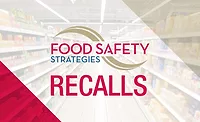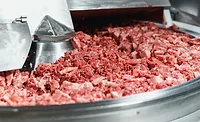Revisiting the Foreign Material Prevention Equation: The Responsibilities of Foodservice
Foodservice executive teams must understand the risk that foreign material (FM) poses to the brand and ensure that the resources for a knowledgeable FM team are a top food safety priority

Video credit: RGtimeline/Creatas Video+ / Getty Images Plus via Getty Images
Foreign material (FM) is a known food safety hazard; however, FM is starting to be seen as an expected and accepted risk in food processing, with a focus on control rather than prevention. With another food safety hazard, Listeria, comments such as, "We expect to find Listeria in our plant," or "If I don't find Listeria, then I'm not looking hard enough," have become common. While there is a modicum of truth to these statements, the result of such thinking is that both plant and corporate leadership become less aggressive in seeking and destroying the pathogen source because it creates a mindset of, "We found it; shouldn't we expect to?" Pathogens must never be found or tolerated on verification sites when corporate leadership has aggressively implemented a true food safety culture. Plant leadership has the support to seek and destroy the pathogen source in the facility by swabbing indicator sites and performing sampling, which is where the pathogen, if present, should be found. A culture of accepting and normalizing abnormal findings is the true root cause of too many failures.
This same acceptance mindset also is present with regard to FM. All food manufacturing processes have inherent FM risks: raw material supply, packaging, plant personnel, equipment, and infrastructure. Any item on the production floor is at risk of finding its way into the product stream. As acknowledgement of this risk, FM detection devices are abundant in production facilities. Food plants will point to this investment in resources as a declaration of being serious about FM control. However, a detection device should never be viewed as a control point; rather, it is an insurance policy against the production and possible release of adulterated food into commerce. It can be a process control tool when located close to an established risk, such as being placed after known equipment wear points; but it must not be viewed as a process control point. Too often, a plant celebrates when the device detects, removes, and captures impacted product from the line. This is not a celebration moment. Much like a pathogen presumptive in finished product, the unthinkable has happened: the plant has produced adulterated product. There now exists indisputable evidence that the FM prevention objective of the food safety program has failed.
Reliance on an FM detection device as a control point is the first step toward accepting FM risk and is akin to the fallacy of inspecting food safety into a product. Prevention of FM in food production is the primary responsibility of maintenance and engineering, with the focus on being preventive and predictive in approach. As a result of this mindset shift from FM control through detection and reaction to prevention, FM incidence will decrease. Plant leaders should know what risks cannot be eliminated and be managing them to such a level (through predictive indicator sites) that an actual rejection by an FM detection device is rare and results in further investigation beyond simple monitoring procedures. The process will be so thoroughly understood that the root cause of any detection is easily determined, and further effective preventive and predictive actions can be implemented.

While the discussion thus far and in the author's original FM prevention equation article1 focused on food production plants, it would be negligent not to acknowledge the role foodservice companies must take in ownership of FM prevention. Foodservice brands must expect their suppliers to emphasize FM prevention; however, they must focus on their own internal operations. Depending on the FM source, either the supplier or foodservice FM teams must focus on identifying the root cause of the failure and implementing preventive practices to remove the FM cause and prevent another adulteration event. They should not focus on selecting the best detection device or how to inspect or re-inspect food safety into a product. Sustainable and validated preventive measures that eliminate FM at the source must be the goal.
Facility and Equipment Design
While considering facility and equipment design to control FM risk has become a normalized behavior in food processing, it is likely that FM risk prevention has not entered some restaurant equipment manufacturers' and brand's mindsets. It is insightful to consider each restaurant as a mini manufacturing facility where inbound ingredients and packaging are further handled to create a finished, packaged product that will be sent beyond the preparation area. Like in the plant, any item in the store is at risk of finding its way into the product stream and adulterating food. Customers have reported finding FM in food where the FM source was the restaurant and not the processor. Investigations of incidents involving a customer must include both internal and external sources.
A corporate foodservice FM team is where the measurements and actions can be created to mitigate FM risk within the restaurant. The FM team, comprising members from the brand's operations, engineering, development, and food safety and quality assurance (FSQA) teams, as well as original equipment manufacturers (OEMs), must have training for FM best practices.2,3 While the Meat Institute's "Food Safety Equipment Design Principles"2 document and "The Meat & Poultry Industry Foreign Material Manual"3 target production facilities, both can be used or slightly adapted to be relevant for foodservice operators and in-store risk assessments. The foodservice FM team must understand the concept of successful FM preventive practices in the restaurant. Expectations around equipment and facility design and maintenance to address FM risks that are placed upon food suppliers must be adapted to restaurants, too.
Supplier Programs
Expectations regarding FM prevention will be developed by the foodservice FM team and communicated to suppliers by the procurement and FSQA functions. As primary compliance monitors, foodservice FSQA team members must devote themselves to becoming educated about their suppliers' FM risk and FM mitigation strategies, including:
- What form are raw materials in, and how are they packaged and managed?
- What is the process flow from receiving to shipping?
- What production equipment is used, and what is the nature of its construction?
- What are the finished product packaging materials and processes?
- What FM hurdles are in place, and what is the level of control provided by each?
- What are the material zoning areas within the plant?
In instances where multiple suppliers exist for a given item, the foodservice brand must insist that FM prevention best practices are not competitive and must be shared. The best way to foster this type of collaboration is to bring all suppliers together and start talking. Ground rules must be set in advance for these discussions to clarify that food safety and FM discussions are not proprietary, are in scope, and are expected. Those suppliers that are unwilling to participate, claim they have nothing to contribute, or say they do not have FM problems have just revealed their food safety culture and commitment to continuous improvement. The foodservice organization can decide how to proceed forward with or without their participation beyond these events. Participation as a supplier must be mandatory. Survival as a supplier is optional.
Looking for quick answers on food safety topics?
Try Ask FSM, our new smart AI search tool.
Ask FSM →
Predictive Process Measurements
Predictive process measurements (indicators) in production facilities must be taken and used to predict and prevent FM failures before adulteration occurs. Some indicators demonstrating the potential loss of FM control are:
- The quantity of wood debris found in open product production zones
- Measured metal dust accumulation on in-line magnets
- Heat measurement of bearings using infrared thermometers
- Equipment vibrations during operations
- Shaft alignments
- Ultrasonic measurements of equipment walls or pieces.
Foodservice must understand the benefit of these indicator measurements and require their suppliers to develop, monitor, and take necessary actions in response to them. This will challenge the supplier to conduct a more thorough and complete risk assessment with actionable outcomes and not just treat it as a "check box activity" to document for auditing later.
Foodservice FSQA should challenge suppliers for their validation of preventive maintenance (PM) tasks. Have instances occurred where a failure was determined before a scheduled OEM PM task was completed and unnecessary downtime was averted? While this may not seem to be the responsibility of the foodservice operator, FM success or failure will be shared between the organizations. By pushing both mature (preventive and predictive) and less mature (awareness and enlightenment) suppliers, a foodservice operator can make a significant difference in the FM maturity state for both organizations and prevent FM contamination.
Similarly, the foodservice FM team can identify measurements that apply to restaurant FM risk. The predictive measurements for foodservice might be more focused on equipment design risks and how to monitor the risk if it cannot be removed. These risks and the identified control methods can then be audited at the restaurant. Audits should not focus only on the obvious tenants of restaurant food safety (handwashing compliance, food, and storage temperatures, and pest control), but must consider all food safety risks including FM and its control.
Root Cause Analysis with Preventive Actions Implemented
The most despised words in the FSQA lexicon should be "corrective action." After any incident, foodservice operators immediately ask their suppliers for corrective action with a misguided expectation that it will happen quickly. Consequently, a plant will do anything to tell the customer that they have done something to rectify the situation, and that all the boxes have been checked. Everyone feels good that action has been taken, and "regularly scheduled programming" resumes, awaiting the next failure to occur. This mindset promotes "firefighting" and reflects a status of awareness and enlightenment on the maturity model scale. Corrective actions are necessary and must be performed, but only to bring the process temporarily under control to allow management of the situation until a permanent preventive solution can be implemented.
Foodservice operators must create expectations beyond corrective actions to FM events, because what is tolerated ends up being what is encouraged. If the firefighting response of a corrective action is tolerated, then this behavior is further encouraged in the future. Foodservice FSQA must ask suppliers for a preventive action issued by the supplier's FM team that explains what is being done to prevent reoccurrence of the root cause in a sustainable manner. This should include a process or procedure change and not just the infamous "re-training" corrective action.
Training alone as a corrective action does not address the deficiencies that may exist with the original training methodology, delivery, comprehension, and retention. Anyone in FSQA that receives a corrective action of "training" alone, without further modifications to process or procedure, should reject it and start asking more questions. If a meaningful change cannot be implemented to definitively prevent reoccurrence of the root cause, then a measurement system must be devised to monitor the risk and predict when issues may occur. All solutions shall be verified as implemented and monitored on an ongoing basis by internal audits to ensure that the gains achieved are maintained. The foodservice customer may then audit to ensure that the solution is truly functioning as intended and has been sustainably implemented. This heightened level of expectations will challenge the supplier to hasten its maturity development regarding FM.
The same concepts apply to restaurant issues. When something from the store equipment or environment finds its way into the product, the FM team must investigate and find the true root cause. If corrective action needs to be communicated to the field to reduce the immediate risk, it should be done in an efficient manner. The team must continue to investigate and discuss how a more permanent, preventive action for the root cause can be implemented. For example, equipment may need to be redesigned and retrofits applied to prevent reoccurrence.
Food Safety Culture
Food safety culture is the current buzz phrase in the food safety space. All companies claim to have a robust food safety culture, but when actions meet words, the commitment starts to waver. To create and grow a food safety culture, the executive team must set clear expectations based on core beliefs and values, and require these expectations be successfully implemented and practiced at all levels of the organization. Culture must be based on values and not priorities; priorities change with business cycles, daily events, and leadership transition. Only a strong, clear values structure with supportive and demonstrable actions, particularly in tough times, will show that a company is serious about food safety culture.
Foodservice executive teams must understand the risk that FM poses to the brand and ensure that the resources for a knowledgeable FM team are a top food safety priority. Creating an impactful foodservice FM team will require an investment of time and financial resources and involves operations, engineering, development, and FSQA. This team must be tasked with identifying both supply chain and restaurant-based FM risks. To do so requires intimate knowledge of suppliers and restaurant operations including both equipment and processes. The culture must then support the team's activities to address and prevent FM risks. A mature food safety culture will eliminate firefighting and create a preventive and predictive continuous improvement expectation. At this level of heightened maturity, FM incidents will become a rare experience. A significant FM incident will have serious repercussions for all functions in an organization. There is no FM silo; the impact of FM runs horizontal within an organization.
Summary
Foreign material incidents continue to plague both the food processing and foodservice industries. These incidents may be minor, resulting in consumer dissatisfaction, or they may be serious, causing significant customer injury or supply chain disruption. The best approach is to use the FM prevention equation to identify all potential internal and external FM risks and apply appropriate preventive measures.
Executive teams at foodservice companies must recognize the risk presented by FM to their operations and brand equity and create a true food safety culture based on values that requires their teams to prioritize FM risk prevention. Leadership personnel within operations, engineering, FSQA, and store development are responsible for assembling an FM team that is tasked with creating supplier and restaurant programs that support this culture expectation. Foodservice teams cannot expect a yearly audit and metal detector standards to mitigate their supply chain risk. Remember, a detector rejection is not a win for food safety; it simply represents a food safety failure that was captured, mitigating the potential negative impact of adulterated food in the market.
Foodservice FSQA teams must proactively get to know their suppliers and programs, and work with the supplier FSQA teams to apply the FM prevention equation in a way that creates preventive and sustainable outcomes for FM. Similarly, the foodservice FM team must examine the restaurant process and equipment to eliminate and prevent FM risk.
References
- Seyfert, M. "A Foreign Material Prevention Equation Based on Listeria Control in Meat Plants." Food Safety Magazine. June 17, 2021. https://www.food-safety.com/articles/7200-a-foreign-material-prevention-equation-based-on-listeria-control-in-meat-plants.
- Foundation for Meat and Poultry Research and Education. “Food Safety Equipment Design Principles.” July 2021. https://www.meatinstitute.org/sites/default/files/original%20documents/Sanitation%20booklet%202021.pdf.
- Meat Institute, National Turkey Federation, National Chicken Council, American Association of Meat Processors, and Southwest Meat Association. "The Meat & Poultry Industry Foreign Material Manual: Considerations for Designing a Foreign Material Control & Prevention Program." 2021. https://www.eatturkey.org/wp-content/uploads/2021/09/Foreign-Material-Manual.pdf.
Mark Seyfert, M.Sc., has a 20-year career in the food industry that spans from farm to fork. He currently works as the Food Safety and Quality Assurance Manager for Taco Bell, where he takes his industry learnings and applies them to his position to protect the end-customer experience. He believes in the structured use of data to predict and prevent issues involving environmental and foreign material control long before an impact is felt on plant operations, company profitability, or negative consumer experiences. He previously worked in R&D and FSQA at Bob Evans Farms, Cargill, and Birchwood Foods.









